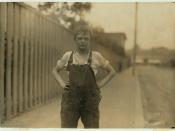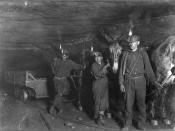Child labor was and is still an existing practice in the world today. Manuel, a five-year old worked at a seafood cannery in Biloxi, Mississippi, with a shrimp pail in each hand and a mountain of oyster shells behind his back. He is typical for thousands of working children in the years before the civil war, especially the turn of the century. America's army of child laborers had been growing steadily for the past century. The nation's economy was expanding. Factories, minds and mills needed plenty of cheap labor. Around 1911, more than two million American children under the age of 16 years of age were a regular part of the work force. Many of them worked twelve hours or more a day, six days a week, for pathetic wages under unhealthy and hazardous conditions.
Thousands of young boys descended into dark and dangerous coal mines every day, or worked aboveground in the dust of coal breakers, picking slate from coal with torn and bleeding fingers.
Small girls tended noisy machines in the spinning rooms of cotton mills, where the humid, lint-filled air made breathing difficult. They were actually kept awake by cold water being thrown in their faces. Three-year-olds could be found in the cotton fields, and twelve-year-olds on factor night shifts. Across the country, children who should have been in school or at play had to work for a living.
By the early 1900's, many Americans were calling child labor "child slavery" and were demanding an end to it. They argued that long hours of work deprived children of an education and robbed them for useful lives as productive adults, child labor promised a future of illiteracy, poverty and continuing misery.
Besides, reformers said, children have certain rights. Above all, they have the right to be children and...


